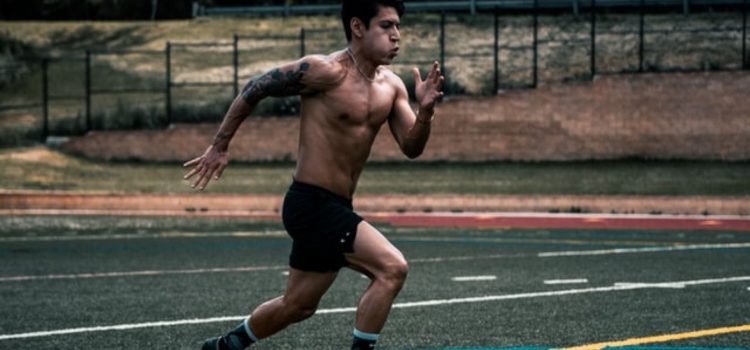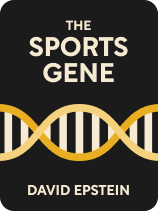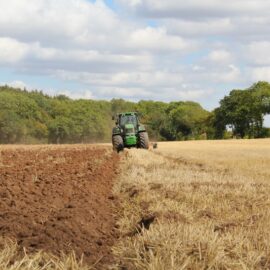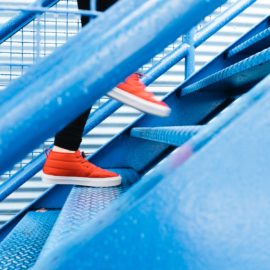

This article is an excerpt from the Shortform book guide to "The Sports Gene" by David Epstein. Shortform has the world's best summaries and analyses of books you should be reading.
Like this article? Sign up for a free trial here .
What role does genetics play in sports performance? Are there specific “sports genes” that confer an advantage in sports?
Our anatomy and physiology are functions of our genes. While we may know that traits are encoded for in our DNA, finding the exact genes that produce these characteristics remains elusive. However, science has made great strides in finding specific genes that impact sports performance.
Keep reading to learn about sports genetics and how genes determine people’s sports performance via response to training.
Genes and the Central Dogma of Biology*
Before we dive into a discussion of sports genetics, we have included a basic refresher on genes.
DNA is housed within the nucleus of our cells. We inherit our DNA from our parents. When cells divide, our DNA is condensed into structures called chromosomes. Each of our cells (except sex cells) has 23 pairs of chromosomes (46 total). One set of chromosomes comes from our mother, and one set comes from our father. The two sets of each chromosome that we inherit from our parents make up our genome.
Certain sections of our DNA, called coding regions, contain instructions for building proteins. These sections are called genes. (Interestingly, the coding sections total only about 1% of our entire genome. Scientists are still trying to figure out what the other 99% does!) Our genes contain the blueprints to make proteins, used to build, run, and protect our bodies. The flow of information from DNA to proteins (via RNA) is commonly referred to as the Central Dogma of Biology. Basically, our genes contain the instructions necessary to build and run a human body (or an onion, a bat, a bacteria, and so on).
*Molecular biology is moving at a rapid pace, and this idea is quickly being shown to be an oversimplification both of what constitutes a “gene” and of the flow of information from genes to proteins. Here is an article from Nature about how the very concept of a “gene” has become less fixed as knowledge advances.
The Human Genome Project
Epstein notes that most of our traits are not produced by a single gene but by the combination of many genes and our environment. To unravel which talents in sports are a product of genes, training, or circumstances, is an impossible task. This is partly why scientists and sports researchers are often hesitant to share ideas and findings that place genes at the forefront of outcomes. To suggest that our potential for success in sports is predetermined runs counter to our cultural values of hard work and determination. It can also lead into socially and culturally problematic territory as certain genetic traits are often distributed along geographic and racial lines.
Since human beings are so complex and sports so diverse, no single genetic trait can be said to determine outcomes in sports. But in recent decades, science has made great progress in demystifying the human genome and identifying individual genes and their roles. In 2003, scientists from around the world completed The Human Genome Project, a massive undertaking that mapped the over 20,000 genes encoded in our DNA. Epstein emphasizes that completion of the project and the information that it has made available has huge implications for technology, medicine, sports, and society.
Scientists’ ability to analyze DNA samples from study participants has allowed researchers to better understand the role of our genes in our response to exercise programs. While we may not yet know the exact genes involved, Epstein cites research showing that our genes play a determining role in how our cardiovascular and muscular systems respond to exercise.
Genes Influence Our Response to Aerobic Training
A 1992 collaborative study between universities in the US and Canada known as the HERITAGE study (HEalth, RIsk factors, exercise Training, and GEnetics) showed that participants on the same training plan showed varying degrees of improvement in response to cardiovascular exercise. The researchers were particularly interested in the effect of the training program on participants’ VO2 max values (which is a measure of how much oxygen our bodies can use while we are exercising). The study followed nearly 100 families (two generations of each family participated, for nearly 500 total participants) over a five-month period. Participants did a prescribed workout three times per week on a stationary bike. Epstein highlights the following results:
- The aerobic capacity of 15% of participants did not improve at all, while the aerobic capacity of another 15% improved by 50% or more. The other 70% of participants fell somewhere between these values.
- How much participants’ aerobic capacity improved did not seem to have any relationship to their fitness levels at the start of the study.
- Results were similar among family members.
- Half of the participants’ base level of fitness and their response to training could be statistically determined just by studying their parents.
As Epstein explains, these results make it clear that there is a strong genetic component to how people’s bodies respond to cardiovascular training. The researchers were able to find 21 alleles (alleles are versions of a gene) that accounted for the response to training that we inherit from our parents.
| High-Intensity Interval Training for VO2 Max HIIT (High-Intensity Interval Training) is a popular way to improve VO2 max. It involves performing repeated short bursts of intense exercise followed by short periods of rest. HIIT has been a popular fitness trend over the last several years. In the annual American College of Sports Medicine survey of over 2,000 fitness professionals, HIIT was ranked as the number one fitness trend in 2014 and 2018, number three in 2019, and number five in 2021. HIIT gives both recreational and elite athletes a big ‘bang for their buck’.Research suggests that, for the same amount of total work, HIIT training is more effective at improving VO2 max than cardiovascular training performed at lower intensities. Research has also shown that gains can be made in VO2 max values from participating in HIIT workouts just twice a week (less than many workout programs using other modalities call for).HIIT allows participants to burn more calories in a shorter amount of time than other forms of exercise and continue to burn extra calories for a few hours after the workout is over (although these effects are not necessarily as large as some proponents of HIIT advertise). A small study showed that even though HIIT workouts are inherently difficult, participants enjoyed them more than moderate cardio training. While this study used a small number of participants and only compared two forms of training, the sustained popularity of HIIT supports these results. A popular and research-backed form of HIIT is Tabata training. Tabata consists of performing 20-second intervals of all-out effort followed by 10 seconds of rest eight times, for a total of four minutes. After one minute of rest, the cycle can be repeated. This workout, in particular, has been shown to increase the VO2 max of exercisers on a stationary bicycle, but the results have been widely applied to other exercise modalities (sprinting, burpees, thrusters, and so on). |
Corroborating Research
- The HERITAGE study corroborated results from a previous study that looked at responses to cardiovascular training in sets of twins. The study showed that training responses were between six and nine times more similar within sets of twins than between sets of twins.
- In another study, 24 men who did not exercise regularly participated in an exercise program on a bicycle. The scientists took DNA samples before and after the six-week program. Results found 29 genes with variations that could predict those participants who did and did not respond to aerobic training. These 29 genes were then correctly used to predict which individuals would respond to training in a subsequent study.
Epstein cautions that we should not take these results to mean that exercise is futile for 15% of people. Even the participants whose aerobic capacity remained unchanged saw improvements in other health parameters such as blood pressure and cholesterol. (While most exercisers saw improvements in insulin sensitivity, the HERITAGE study did find that some people may be genetically predisposed to become more insensitive to insulin in response to exercise.)
Genes Influence Our Response to Strength Training
Similar to our cardiovascular system, our muscles also respond to exercise to varying degrees. Epstein highlights a study of 66 participants in a four-month program involving various strength training exercises that found similar results to the HERITAGE study.
- 17 participants added up to 50% more muscle mass.
- 32 participants gained 25% more muscle mass
- 17 participants had no muscle gains despite identical training
Also similar to the HERITAGE study was that those who responded the most to the training program had pre-existing genetic differences from those who did not. Epstein notes that the participants who gained 50% more muscle had more active IFG-IEa, MGF, and Myogenin genes than those who did not respond to exercise. Additionally, those who responded the most to exercise had more muscle satellite cells (stem cells that sit outside the muscle fibers and help muscles become bigger and stronger in response to training). While these results do not provide a clear reason why some people gain strength more readily than others, they show that genes play a determining role.
(Shortform note: It is important to keep in mind that all participants had the same genes. Differences did not result from which genes were present but from the degree that participants’ bodies used those genes to make proteins.)
Corroborating Research
Epstein highlights two other studies to support the idea that genes determine training responses.
- A study of 442 participants in a strength-training program found that gains ranged from less than 50% to more than 200%.
- A study of 585 participants found that, after 12 weeks of training, some participants’ upper arm strength increased by 250%, while some did not increase at all.
Epstein uses the results of these studies to provide two important insights into how people respond to exercise and training.
- First, some people are simply naturally more fit than others. He supports this conclusion with additional research:
- In a survey of the cardiovascular fitness of 1,900 Toronto firefighter hopefuls, six had no training and led sedentary lifestyles, yet they had similar VO2 maxes to collegiate runners.
- One study of 26 elite runners who stopped competing found that 15 years later, they still had high VO2 maxes (even if they were overweight and not training).
- Second, the extent to which we respond to some types of training is genetically determined.
- This has important implications outside of sports. If doctors can use genetic testing to determine whether patients respond to exercise training, they can tailor interventions to best suit individual patients. For those deemed “non-responders” to exercise, doctors could save patients time and frustration and prescribe medication.
- Many people may self-select out of their sport when they feel frustrated after having hit a training plateau. These may be people who had some initial success due to their baseline fitness but simply do not respond to training to the degree of their competitors.
According to Epstein, many elite athletes likely fall into both the naturally fit and high response to exercise categories.
| Other Measures of Success in Training Programs Exercise can help us perform better in our daily lives. Epstein’s research highlights two ways that people can “respond” to exercise training programs. However, as noted in our comment on exercise and changes to our brain and mood, there are many other ways we can benefit from a training program beyond strength and VO2 max. According to the CDC, regular exercise can help reduce the risk of falls, especially in older adults. It can also reduce pain caused by conditions such as arthritis and joint problems and reduce mortality (from all causes) by 33% (based on 150 minutes of exercise per week). We would all love to see impressive gains in fitness when we invest time and effort at the gym. But being able to walk up stairs, pick up a child, or even get dressed without pain or fear of falling are all ways that our bodies can “respond” to exercise that a single metric cannot measure. |

———End of Preview———
Like what you just read? Read the rest of the world's best book summary and analysis of David Epstein's "The Sports Gene" at Shortform .
Here's what you'll find in our full The Sports Gene summary :
- A look at how our genes play a determining role in our success in sports
- Why practice doesn't always guarantee success
- The fortuitous gene pairings that can lead to elite athleticism






